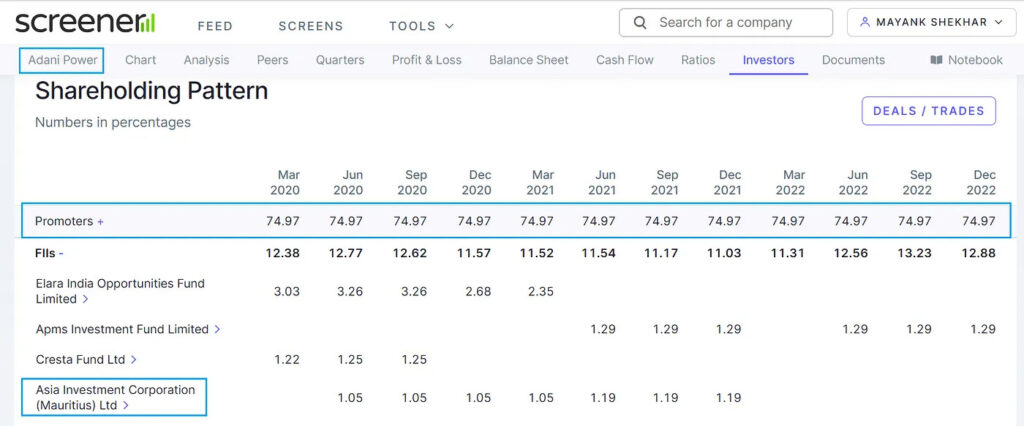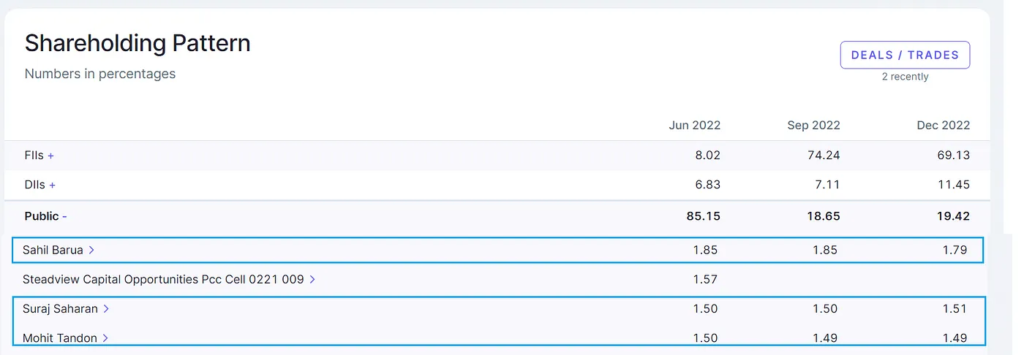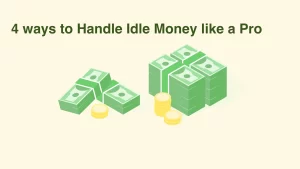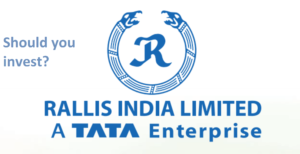How to use Promoter Shareholding in Stock’s Fundamental Analysis?

Why should I worry about Promoter Shareholding?
If you have tried learning fundamental analysis, either via online courses, books, or YouTube videos, you would have come across the term Promoter Shareholding. Promoter shareholding is the percentage of shares held by the promoters (or founders) of the company. Typically, the advise you get is, higher the promoter shareholding, the better it is. This is true, and also not true in some cases. In this post, I will cover all the hidden stories promoter shareholding tells you, and how you can use this metric while picking stocks. Lets get started.
When High Promoter Shareholding is Good
High promoter shareholding means that the wealth of the promoters is tied with the company. If the company performs well, its revenue and profits will increase. This will increase the company’s stock price. Stock price increase will create wealth for the promoters, and retail investors like us. Therefore, high promoter shareholding is also called as promoters having ‘skin in the game’.

How much shareholding is high?
There is no formal definition of high promoter shareholding. Based on listed companies, one can say that 30% to 60% can be called the range of high promoter shareholding. If a company’s promoters have shareholding in this range, it can be considered a good sign.
Example 1: Divis Labs. Divis Labs is a leading API manufacturer founded by Mr Murli Divis. Its promoters, the Divis family, hold around 52% of the company. This has remained constant in the past 12 quarters.

Example 2: Reliance Industries. Reliance is led by Mr Mukesh Ambani. It deals into Oil business, has expanded to telecom sector via Jio, and to eCommerce and Green Energy verticals recently. Promoters of Reliance Industries hold around 50% of the company. This holding has remained constant over the past 12 quarters.

Divis, and Reliance are well known companies, which have created wealth for their investors. Their promoters are invested in the company, and maintain a high shareholding.
How to read promoters reducing their shareholding?
Even with high promoter shareholding, you may come across a situation where promoters are seen reducing their shareholding in the company.

When promoters reducing their shareholding is bad
If a promoter is consistently reducing shareholding over multiple quarters, without giving reason for the same, then it is a worrying sign. It means that the promoters’ interests now lie outside of the company. It can also mean that the company is expected to see turbulent times ahead, making the promoters take the partial exit route.
An example is the famous Satyam scam (read more on this on wiki here). Satyam was an IT company, which did fraud by falsifying its account books. Satyam’s promoters consistently reduced their holding in the company from 25% to 2% (refer research article here).

To avoid such situations, you should look for: (a) Consistent reduction in promoter shareholding which lasts for more than 2 consecutive quarters (b) Look for public statement by promoters explaining the reduction in shareholding. If a is true, and b is not available or is generic, then it is a worrying sign, and probably a red flag.
When reduction in promoter shareholding is NOT a worrying sign
Promoters can reduce shareholding to book partial profit, or use the money to pay off company debt. It can also be a case of promoters onboarding a Private Equity firm, thus shelling out their equity to the PE firm. In latter, the investment firm can be bucketed either as a new promoter, or in the public shareholder section.
In such cases, the reduction in promoter shareholding will be a one off instance, and will not last for multiple consecutive quarters. Also, there will be a news article, or public statement by the company or promoters, explaining the reason behind the shareholding reduction.
Example: Laurus Labs is a leading API company. Its promoters sold 1.3% share in the company in 2020. There was a public announcement by the company (read article here). The statement revealed that the promoters have sold these shares to release the pledged shares taken by the promoters. The pledged shares were in turn taken to fund company’s expansion plans.
Now, armed with this knowledge, you set out to create a stock screener to shortlist high promoter shareholding companies. But you find that some of the well known, trusted companies, are not coming in this screener. Companies such as Axis Bank, ICICI Bank, HDFC Bank, ITC, have zero or very low promoter holding. You seem confused. These are decade old companies, with a high buy rating by stock analysts. What are you missing here? Lets find out in the next section.
When Low Promoter Shareholding is Good
Yes, you read it right. Low promoter shareholding can also be good. There are certain cases where high promoter shareholding is either not allowed, or does not exist by design. Lets dig deeper.
Regulation on Promoter Shareholding in Banks
RBI requires private banks to have low promoter shareholding. Promoter shareholding is required to be decreased over regular intervals of time, and should not be more than 10% in the long run (read RBI circular here).

So, it is natural for private banks to have very low promoter shareholding. Sometimes as low as zero in the case of ICIC Bank.
Professionally Managed Companies
Professionally managed companies do not have a promoter. The company’s CEO reports to the Board of Directors of the company. ITC is one such example. Therefore, you will see that ITC has zero promoter shareholding.
Professionally managed companies can give performance based shares to the CEO, or top management. However, these shares will be less, and not entitle the CEO to become a promoter. Example: Mr Satya Nadella, current CEO of Microsoft company, gets a part of his compensation as shares of the company Microsoft. But this does not make him the promoter of Microsoft. The promoter, or founder of Microsoft, remains Bill Gates.
When Too High Promoter shareholding is bad
Too high promoter shareholding can actually be a worrying sign. Regulations require listed companies to have at least 25% holding by public. This means that a company’s promoters can have maximum 75% sahreholding. Generally, promoters allow retail investors, and institutional investors (mutual funds etc.), take a larger chunk (more than 25%)of their company. If a company’s promoters own near to 75% of the company, then that may require some digging into.
Example: In the Feb 2023, the Hindenburg report on Adani group, one of the allegations is that Adani Group has very high promoter shareholding of 75%. It also alleges that Adani, via some Mauritius based holding companies, own further stake in the company. Thus, Adani controls around 80% or more in the listed Adani companies (refer image below). This will allow Adani to manipulate stock price by selling and buying among promoters and their holding companies. Stock price is nothing but demand and supply of the shares of a company. Stock price goes up when there is more demand, and less supply. If this mechanism is misused by promoters, they are wrongfully manipulating stock price to create wealth for themselves.

If you think about it, a company which goes public via IPO route, is looking to raise capital by selling its shares to the public and institutional investors. This capital is used for company’s growth. If a company does not want to dilute its shares, why should it do IPO? It can as well remain private. Zerodha is one such example. Zerodha is a highly profitable company, and generates good cash flow to keep fueling the growth engine of the company. Hence, Zerodha never felt the need to go public.
Therefore, if a company’s promoters have very high shareholding, then something fishy might be going on which needs digging into.
Promoter Holding in New Age Tech companies
New age tech companies seem to operate in a different world. They are non-profitable, chase growth at any price, devise new terms to report their financial performance, and have low promoter holding. We will focus on the last part in this section.
New age tech companies choose the path of fast growth. This is achieved by raising Venture Capital (VC) money early on. Sometime, VC funding is raised as early as product launch, or even pre revenue. What do VC firms get out of this? VC firms get shares in the company. As new age tech companies raise money early on in the company’s lifetime, they have to shell out a large chunk of share to VC.
Example: Bhavish Aggarwal, founder and CEO of the largest cab aggregator platform in India, OLA Cabs, has little over 6% stake in his company (read Marcellus Investment advisors’ article on the same here).
Lets look at some listed new age tech companies in India. Delhivery, a logistics tech company, has zero promoter shareholding. Its three co-founders, Sahil Barua, Mohit Tandon, and Suraj Saharan own around 1.5% each in the company (refer image below).

This process of raising VC money, shelling out company ownership, is totally different from traditional approach of building companies. Traditional companies grow slowly, take debt to fuel their growth, do Join venture to diversify, and all that time retaining high promoter shareholding. The downside is slow, boring growth rate. But is it boring, if you get to keep the majority of the company you sweat to create?
Hence, for new age tech companies, do ignore the low promoter shareholding of founders in the company. Use other indicators to do the fundamental analysis of the company.
Summary — Promoter Shareholding Analysis Grid
Below tabular grid summarizes the points in this post. You can keep this snapshot to be used in your Fundamental Analysis arsenal.

Parting Thoughts
If you have made it this far, you know all there is to know about analyzing the Promoter Shareholding in a company. You now can decode the story behind a company’s promoter holdings. Do note that once you feel you know everything there is to know, the stock market chooses to teach you a thing or two anew. So keep your learning eyes and ears open, and learn new cases of promoter shareholding as they surface. Either regulatory changes, or the way companies raise capital, can have an impact on reading promoter shareholding.
Who would have thought that this simple metric of promoter shareholding can tell us, retail investors, so much about the underlying intention of the promoters. Not only that, analyzing promoter shareholding can provide us a small crystal ball glimpse of the future prospects of the company.
What is the promoter shareholding in your favorite listed company? Do share in comments below.
Happy Investing!
Disclaimer: I am not a SEBI registered advisor. DYOR before taking buy/sell decisions.




